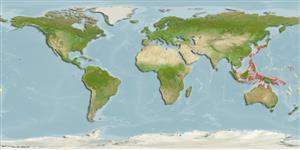>
Blenniiformes (Blennies) >
Blenniidae (Combtooth blennies) > Salariinae
Etymology: Rhabdoblennius: Greek, rhabdos = stick + Greek, blennios = mucus (Ref. 45335).
More on author: Günther.
Environment: milieu / climate zone / depth range / distribution range
Ecologie
marien rifbewoner; diepte 0 - 2 m (Ref. 76835). Temperate
Western Pacific Ocean: southern Japan to Taiwan, Philippines and Malaysia.
Grootte / Gewicht / Leeftijd
Maturity: Lm ? range ? - ? cm
Max length : 8.3 cm SL mannelijk / geslacht onbekend; (Ref. 76835); 5.6 cm SL (female)
Dorsale stekels (totaal): 12; Dorsale zachte stralen (totaal): 18-22; Anale stekels 2; Anale zachte stralen: 19 - 23. Teeth on jaws immovable, fewer than 40 in each jaw. Terminal anal fin ray connected by membrane to caudal peduncle. Nasal and supraorbital cirri simple, nuchal cirri absent. Both sexes with occipital crest.
Facultative air-breathing (Ref. 126274); Adults are usually found on the outer reef front of surge channels and pools, exposed to heavy surf. Oviparous. Eggs are demersal and adhesive (Ref. 205), and are attached to the substrate via a filamentous, adhesive pad or pedestal (Ref. 94114). Larvae are planktonic, often found in shallow, coastal waters (Ref. 94114).
Levenscyclus en paargedrag
Maturiteit | Voortplanting | Paaien | Eieren | Fecunditeit | Larven
Oviparous, distinct pairing (Ref. 205).
Bath, H., 2004. Revision of the genus Rhabdoblennius Whitley (Pisces: Blenniidae: Salariinae), with descriptions of two new species. Stuttg. Beitr. Naturkd. (A Biol.) 669:1-28. (Ref. 76835)
Status op de Rode Lijst van het IUCN (Ref. 130435)
Gevaar voor de mens
Harmless
Gebruik door de mens
Meer informatie
ReferentiesAquacultuurAquacultuurprofielKweeklijnenGeneticaElectrophoresesErfelijkheidZiektesVerwerkingNutrientsMassaconversie
Tools
Speciale rapporten
Download XML
Internetbronnen
Estimates based on models
Preferred temperature (Ref.
123201): 21.6 - 29.2, mean 28.7 °C (based on 920 cells).
Fylogenetische diversiteitsindex (Ref.
82804): PD
50 = 0.5312 [Uniqueness, from 0.5 = low to 2.0 = high].
Bayesian length-weight: a=0.01072 (0.00480 - 0.02393), b=3.01 (2.82 - 3.20), in cm total length, based on LWR estimates for this (Sub)family-body shape (Ref.
93245).
Trofisch niveau (Ref.
69278): 2.0 ±0.00 se; based on food items.
Weerstandsvermogen (Ref.
120179): Hoog, minimale populatieverdubbelingstijd minder dan 15 maanden (Preliminary K or Fecundity.).
Fishing Vulnerability (Ref.
59153): Low vulnerability (10 of 100).
